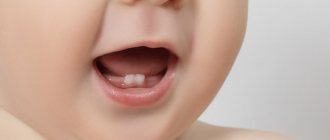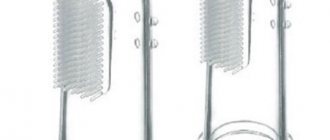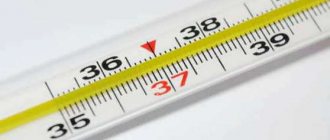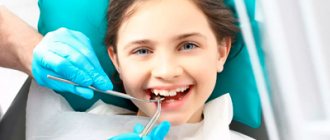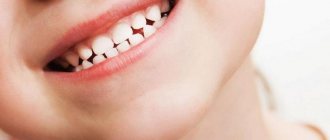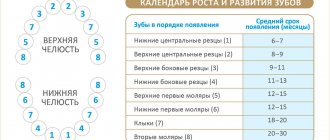Having asked such a question to a search engine, it is not easy to find a useful article that would tell why a child aged 10-11 months has no teeth and what to do in such a situation, why a one-year-old child still has no teeth, or why one should not panic in such a situation. situations. You will come across forums where women who have no idea about medicine try to help each other.
For help with any problem, you should turn to professionals. It is better if it is a doctor, but if he is not nearby, then it is better to trust at least articles that are based on some accurate medical data, especially when it comes to teething in a child at 10-11 months.
Next, we will look at what to do and what to do if your child is already 10 or 11 months old or even a year old, and he still does not have chewing organs, is there any reason to panic in such a situation and what should be done, and what is better? abstain.
Impaired teething
Baby teeth are important for the development of a child and one cannot underestimate how much a child needs them at 10, 11 months, and a year. They allow him to eat adult food, develop and
grow correctly. The development of the facial segment directly depends on how well the chewing apparatus is developed in the child’s mouth.
Eruption disorders are considered a pathology, which includes the absence of teeth at a late age, incorrect eruption sequence, and underdevelopment during their emergence from under the gums.
To better understand what happens in a child's body and how certain factors can affect the chewing organs, it is best to first look at how teeth erupt and where they come from.
The order of eruption of baby teeth.
The first teeth that a child begins to erupt at the age of 5 - 8 months on the lower jaw are the deciduous incisors. Next, the central primary incisors on the upper jaw begin to appear. At the age of 9 - 13 months, the lateral incisors on the upper and lower jaws erupt. At the age of 13 - 19 months, the first chewing teeth (first primary molars) are cut on the upper and lower jaws. A gap is formed between the lateral incisors and molars, during which the primary canine begins to erupt at 16 months. The last to begin to emerge is the second chewing tooth (second primary molar), first on the lower jaw, then on the upper jaw. By age 3, a full set of baby teeth should have formed.
Development of the dental apparatus
The digestive system is of central importance in human life, as well as in other creatures. Therefore, organs that belong to the digestive system are formed very early in the process of embryonic development. Already at 3-4 weeks of development, the embryo has an intestinal tube and the rudiment of a mouth, which interests us primarily. At the same time, the development of the dentition begins, the formation of the primary occlusion and the rudiments of permanent teeth.
Milk and permanent teeth are inextricably linked, because until the child grows his first permanent teeth, that is, until he is 6-7 years old, they will be replaced by temporary teeth. By the time of birth, they are well developed and ready to erupt in the near future, but the first ones - not earlier than 10-11 months.
The eruption of chewing organs is probably one of the central events in the life of the baby and his parents, because this process is associated with stress for the child. Parents are also very worried, trying to ease the fate of their baby, but what to do if the due date has come, but the teeth have not erupted?
First, let's define what a “deadline” is in this case. A child’s first teeth appear at 6-8 months of life, although it is possible that they may appear later. Therefore, do not worry if there is a slight delay. The lower jaw will be filled first, followed by the upper jaw. This is necessary for the child to develop a correct bite, that is, the teeth are positioned correctly in relation to each other. You will learn more about the sequence of teething in this table:
Each organism is individual, but there are cases in which parents should pay attention to how their child’s teeth develop:
- delay in teething for more than several months, for example up to a year;
- early dental development;
- the order of eruption at 10 or 11 months is disrupted;
- tooth missing or out of shape at 10 or 11 months;
- The dentition appeared even before the baby was born.
Teething
According to the tradition of many peoples of the world, there is a custom of giving gifts to a child on the occasion of the appearance of the first tooth. This ritual symbolizes wishes to the baby for health, happiness and long life. The appearance of a baby’s first tooth is a solemn moment for relatives and parents, but at the same time, teething can also be a “restless” period for parents and the baby. I would like to reassure parents and orient them to the fact that teething is a physiological process and must be approached philosophically. As if it were inevitable. And timely and correct teething is a guarantee of a healthy future child.
What is teething?
Teething is the process of vertical movement of a tooth from its origin and development within the jaw until a crown appears in the oral cavity. The process of teething begins after the crown has finally formed and is accompanied by its further development and growth of the jaw bones. Signs of physiological teething are: timeliness, sequence of eruption of certain groups of teeth and pairing.
There are temporary teeth (more often called milk teeth) and permanent teeth. According to the number of teeth, the primary teeth are 20, the permanent bite is 32 teeth. According to modern data, the period for the eruption of the first temporary teeth is usually considered to be from 4 months. The end of eruption is 3-3.5 years. Most often, the first teeth appear at the age of 6 months, and as a rule, the teeth on the lower jaw erupt first - the central incisors, then the lateral incisors, canines and molars. The timing of teething can vary from 4 months to 2 years (early teething) or from 8-10 months to 3.5-4 years (late teething).
Average time for eruption of primary teeth according to (R. Illingworth, 1997)
| tooth | Timing of eruption (month of life) | |
| Lower jaw | Upper jaw | |
| Central incisor | 6 | 7,5 |
| Side cutter | 7 | 9 |
| First molar (chewing group of teeth) | 12 | 14 |
| Fang | 16 | 18 |
| Second molar (chewing group of teeth) | 20 | 24 |
It should be noted that the quality of nutrition, sanitary and hygienic conditions and pathological conditions of the child (rickets, hypovitaminosis, intoxication, states of oxygen starvation, the nature of feeding, etc.) significantly affect the process of teething. For example, disordered teething with disruption of the time intervals between groups of teeth, delayed eruption may be a manifestation of a pathology such as rickets.
Adverse effects during teething
Temporary teeth are not permanent, that’s why they are called that. As the child grows and develops, after a certain period of time, all 20 primary teeth will be replaced. As an exception, in individuals, milk teeth do not change, remaining in adulthood (most often this occurs due to the absence of the rudiments of permanent teeth).
When primary teeth erupt, the child is in a state of “stress” and can often manifest itself with general somatic disorders. The first signs of teething, often the main ones, are the appearance of swelling of the mucous membrane of the gums in the projection of the erupting teeth. Profuse salivation appears, the child may be irritated and tearful. The eruption of central teeth often occurs without any manifestations, except for swelling of the gums and profuse drooling. When the chewing group of teeth erupts and a larger area of the gum mucosa is involved, a secondary infection may occur if the resistance of the child’s body decreases. Symptoms such as increased body temperature, upset bowel movements, redness of the mucous membrane of the gums in the mouth, decreased appetite may appear. To relieve the annoying itch, the child begins to “drag” fingers and various objects into the mouth (toys, sucking the edge of clothing, a blanket) to scratch gums, thereby can damage and infect the mucous membrane. Which can manifest itself as erosive rashes. And aggravate this condition.
How can you help your child when they are teething?
To relieve itching of the gums in a child, it can be recommended to give hard vegetables or fruits (peeled apples, carrots), or a crust of bread to chew. It is good to massage the gums with special “teether” rings or a toothbrush (silicone, or a regular baby brush with soft bristles). Some rings can be pre-cooled, but you should carefully inspect these devices and purchase them in special places in order to avoid counterfeit, uncertified goods and subsequently not harm the baby’s health, so that the child does not get hurt. If the temperature rises, antipyretic drugs can be given. To reduce the sensitivity of the mucous membrane and reduce pain in pharmacies, pharmaceutical manufacturers offer special anesthetic gels for topical use. But we recommend using these drugs only as prescribed by a doctor, so as not to cause allergies in the baby and not miss more severe complications. Contact a pediatric dentist who will conduct an examination and give qualified prescriptions to improve your well-being.
Changing temporary teeth
Permanent teeth most often appear between 5.5 and 7 years of age. Their eruption practically occurs in the same sequence as temporary teeth. The lower central incisors appear first, then the upper central incisors, and in parallel, and sometimes earlier, the first large molars erupt (the first molars, or by their number, they are called “sixths”). Please note: The sixth teeth do not fall out! They should serve your child for life. Parents mistake them for temporary teeth, which is a misconception, especially in the case of absence or poor oral hygiene and damage to this group of teeth. Which can lead to a disastrous result – tooth loss. But this group of teeth - the “First molars” - are fundamental in the formation of a correct bite; they are also called the key of occlusion. The shape of permanent “young” teeth differs from more mature ones. The cusps and cutting edges of the crowns are more pronounced, especially the cutting edges of the central teeth have a scalloped (wavy edge), the size of a permanent tooth differs from a temporary tooth, it is larger. Some parents are alarmed by this fact. To which we answer, there is no reason to worry, literally a year after eruption, the enamel edge will become even and even. And regarding the size of the crowns of the teeth, while the child is small (the appearance of the first permanent teeth is 5.5-6 years old) relative to the facial skeleton, there is a certain disproportion; as the bones of the facial region grow and develop, a harmonious relationship between the face and teeth occurs.
Average time for the eruption of permanent teeth in children (according to Schroder, 1991)
| tooth | Timing of eruption (child's year of life) | |
| Lower jaw | Upper jaw | |
| Central incisor | 6-7 | 7-8 |
| Side cutter | 7-8 | 8-9 |
| Fang | 10-12 | 11-13 |
| First premolar (small molar) | 10-11 | 9-10 |
| Second premolar (small molar) | 11-12 | 10-11 |
| First molar | 5-6 | 6-7 |
| Second molar | 12-13 | 12-14 |
| Third molar (wisdom tooth) | 15 and older | 15-16 and older |
1. In order for the teeth to last a long time and not have to “say goodbye” before the appointed time, they need careful care when they erupt.
2. Go ahead for a consultation with a pediatric dentist, who will select age-appropriate hygiene products (toothbrush and toothpaste) for your child. He will provide training in teeth brushing techniques.
3. Brush your child’s teeth at least 2 times a day (in the morning after breakfast and in the evening before bed). Helping clean hard-to-reach areas from an early age
4. Limit your child’s consumption of carbohydrate-containing foods (we do not recommend eating sweets for children under 3 years old)
5. If a child drinks liquid drinks before bed or at night, they must be replaced with regular drinking water, without added sugars.
6. The use of toothpastes containing fluoride is very important for children of the Khanty-Mansiysk Autonomous Okrug-Ugra
7. Visit the dentist 2 times a year!!!
The article was prepared by: pediatric dentist Malakhova A.A. Head of TOD - Mokrinskaya N.G.
Photos used in the article from satyov:
1. https://ladyspecial.ru
2. https://otvetymamam.ru
Causes of eruption disorders
As we noted earlier, the formation of teeth and their further formation occur in the early stages of pregnancy. Therefore, a common cause of pathologies are disturbances in the development of the fetus in the first 4 weeks of development or diseases suffered by the mother during pregnancy. There is probably no need to say that the first trimester is key and most important, because at this time all the systems of the future person are laid.
Diseases that can cause incorrect development of teeth include the following:
- rubella;
- congenital syphilis;
- measles and other dangerous diseases.
Bad habits of the mother and her environment negatively affect the development of the fetus: smoking (active and passive), drinking alcohol, taking medications prohibited for use by pregnant women, and so on.
There is no denying that hereditary factors and unique characteristics of the body significantly influence the eruption of baby teeth.
Treatment options
A child may experience diarrhea with mucus during teething
The younger the child, the more dangerous diarrhea is for him. Even slight dehydration for a small body can lead to dire consequences. Therefore, it is necessary to take urgent measures, trying to correct the condition. What should you do first?
Restore lost fluid and salts. If we are talking about a baby, you cannot stop breastfeeding. The same rule applies to artificial people. You just need to try to feed more often, but in smaller amounts. When diarrhea in an infant is accompanied by vomiting, it is necessary to seek help from a medical facility in order to restore water-salt losses with the help of a dropper.
If there is no fever or vomiting, you can perform a number of manipulations yourself that will help stop diarrhea. To do this, increase the amount of fluid entering the body. The volume of additional fluid should correspond to the volume that came out with diarrhea. Special solutions are used as such additional liquid. These are Regidron, Oralit, Acesol.
It is imperative to organize the supply of glucose. You can just give sweet tea. Depending on the situation, liquid is given between feedings through a bottle, from a spoon or from a syringe (without a needle). If the child refuses, you need to drink at least 1 teaspoon every 10 minutes. If it doesn’t work out, you need to go to the hospital; you can’t leave the baby without help.
Dehydration can be identified by the following symptoms: dry lips, palms, feet, weakness, sunken eyes. To control, you can grab the skin from the abdomen with your fingers and look. How the resulting fold will behave. If there is dehydration, it will return to its original position slowly.
Taking medications as recommended by a doctor. For example, Enterofuril, Furazolidone, Stop-Diar. If diarrhea occurs as a result of the action of pathogenic microflora, then it is treated with special bacteriophages. There are Staphylococcal bacteriophage, Klebsiella bacteriophage, and others.
Symptoms of disorders
There are special formulas that show how to correlate the age of a child with the number of chewing organs cut through him and understand whether everything is going well, but we are not going to overload the reader by immediately getting to the point.
The concept of a norm in this case is very flexible, because in different sources we will find different terms. Some pediatricians insist that the eruption of the first teeth later than the eighth month of life is a pathology, others argue that this is quite normal, but it is impossible to separate pathology from the norm without studying a specific patient.
Even if there is a delay in dental development, if the child looks healthy and no systemic pathologies are detected, then parents can calm down and wait a little until the teeth begin to cut.
If the child is sick, then this may be a problem with his teeth. Early eruption, for example, can be both an individual characteristic of the body and evidence of incorrect functioning of the endocrine glands.
Main causes of diarrhea
Eating disorders can lead to diarrhea
There are several very common causes of diarrhea that cause loose stools. They are harmless and do not require treatment. Such reasons include the following:
- power failures;
- an abundance of eaten fruits and vegetables;
- climate change;
- excited state;
- ARVI;
- taking medications to lower the temperature;
- teething
The leading indicator that special treatment is not required is the child's good condition. If a baby is breastfed and develops diarrhea, it is likely that the mother is eating unwanted foods or her milk is not sterile. In this case, an examination of the nursing woman is required.
There are other causes of childhood diarrhea. They require specialist consultation and comprehensive treatment. This type of reasons includes the following:
- gastroenteritis;
- intolerance to gluten, cow's milk, enteroclitus;
- lactase deficiency;
- binge eating.
Causes of pathology
So, let's imagine for a moment that the eruption of the first teeth after the eighth month of life is truly a pathology. What could be the reason for this phenomenon, when a child has no teeth at one year or at 10-11 months?
Poor nutrition, lack of necessary substances for the development of teeth in the body. In such a situation, parents need to reconsider their child’s diet and add more foods containing minerals like Calcium, Magnesium, and carbonates.- Presence of gastrointestinal diseases. The chewing organs are connected to the entire digestive system, and they cannot develop independently of it.
- Rickets. Rickets occurs when there is a lack of vitamin D in the child’s diet or metabolic disorders.
- Disturbances in the functioning of the hypothalamic-pituitary system, which is responsible for all processes in our body.
- Presence of genetic abnormalities.
How to help your baby with teething
To alleviate the child’s condition and partially relieve pain syndromes, parents can perform a light gum massage. To do this, wrap your finger in a sterile medical bandage and massage the inflamed areas. You can lubricate your gums with a special ointment with a cooling effect, which is sold at the pharmacy. Dentists also recommend making compresses with decoctions of medicinal herbs, such as chamomile.
When teeth pecking, children try to chew on various objects. In this case, offer your baby a rubber teether or a silicone teething ring, pre-chilled in the freezer. Cold will help relieve unpleasant pain.
It is important to know: during the appearance of incisors, monitor the child’s drinking regime, give him plenty of water to prevent loss of fluid in the body.
During this period, you should be sensitive to the baby, play with him, find interesting activities for him. This will help him redirect his attention and take his mind off the pain and discomfort.
Treatment and prevention
Treatment for delayed development of primary teeth always depends on the cause of this phenomenon. The doctor needs to understand what is going wrong in the child’s body and then prescribe treatment specifically for this ailment. It is impossible to cure teeth that do not erupt, because there is always
there is a specific reason why this is not happening. It is also necessary to determine whether the child has any rudiments of teeth at all, because if they do not exist, then other measures will have to be taken.
If teeth erupt early, then parents need to worry about caries not “eating” them prematurely. But if a child does not have chewing organs at one year or 10-11 months, this can be a problem.
Prevention of teething disorders cannot exist, because when a child is born, the parents have a colossal influence on its development, but the entire basis has already been laid, so the main attention should be paid to the health, nutrition and lifestyle of the pregnant woman.
Teething symptoms
The symptoms of pecking baby teeth are the same for all children. The first signs include excessive salivation and inflammation of the gums. Most often, they appear a few weeks before teething, but there are cases when the gums itch from 3 months, which causes discomfort to the baby, and he begins to pull various objects into his mouth.
Often the child experiences indigestion, poor appetite, and sleep disturbances. There are times when the temperature rises slightly, diarrhea, runny nose, and wet cough may appear. Children’s behavior often changes: they become capricious, cry for no reason and ask to be held by their parents.
It happens that these signs indicate other diseases, so it is better not to delay visiting a doctor.
Consequences of early destruction of primary teeth
After the early removal of a baby tooth, the gum in its place becomes overgrown, and the permanent one is deprived of its natural landmark. This leads to phenomena such as:
- dystopia - eruption of a permanent tooth outside the dental arch;
- retention - the occurrence of a formed tooth in the thickness of the jaw bone.
If the baby tooth does not receive treatment, and the inflammatory process spreads to its roots, then the permanent follicle located under them is damaged. In this case, the permanent one may die, and then its place in the dentition will remain empty. The absence of a tooth is confirmed by radiography.

